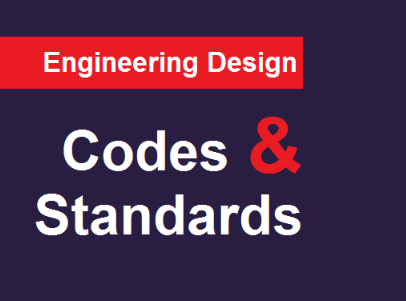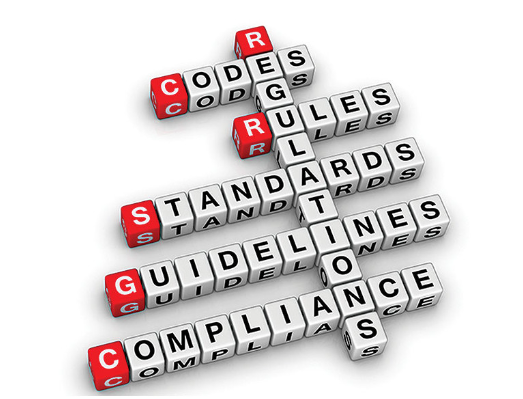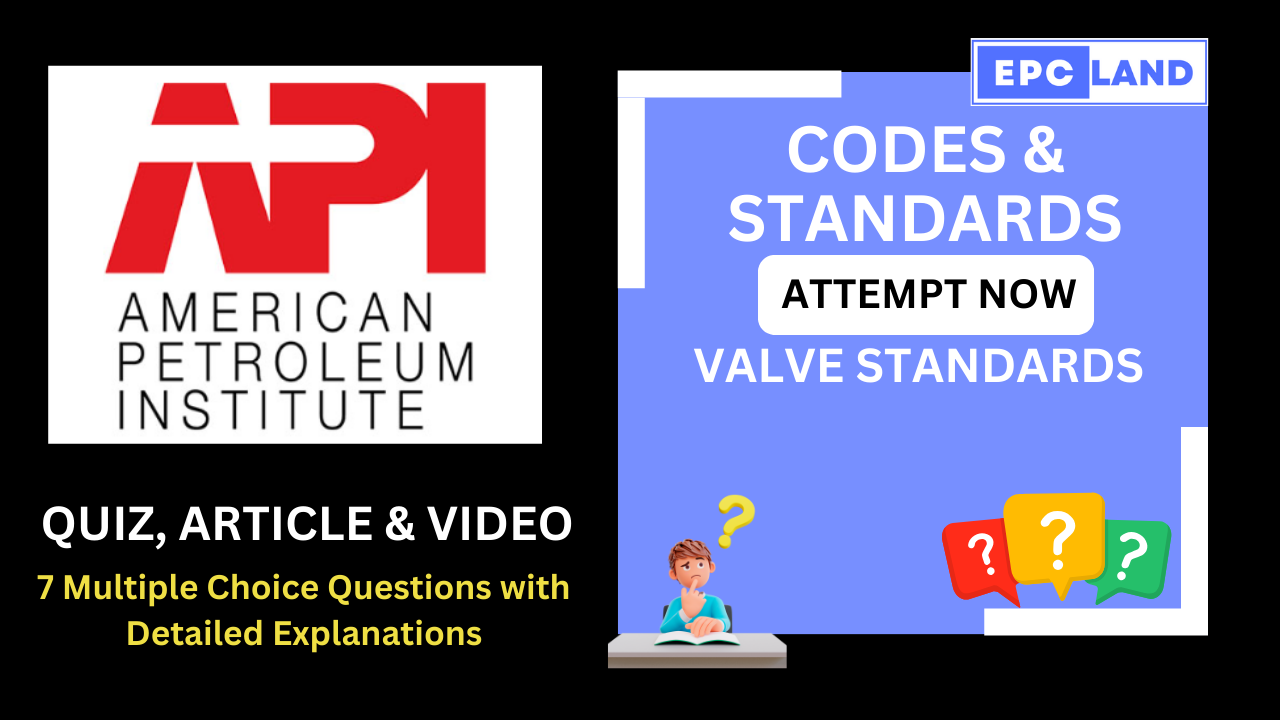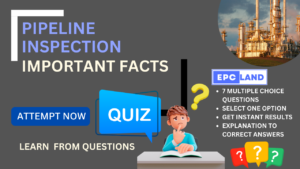

1. API STD 520 Part I
What does API STD 520 Part I cover?
Explanation: API STD 520 Part I covers the sizing and selection of pressure relief devices for refineries and related equipment.
2. API STD 526
What does API STD 526 specify?
Explanation: API STD 526 specifies requirements for flanged steel pressure-relief valves, including orifice size, pressure rating, materials, and temperature limits.
3. API Spec 6D
What does API Spec 6D focus on?
Explanation: API Spec 6D specifies requirements and recommendations for the design, manufacturing, testing, and documentation of ball, check, gate, and plug valves for pipeline systems.
4. API STD 598
What does API STD 598 outline?
Explanation: API STD 598 outlines inspection, examination, and pressure testing requirements for various valve types, including gate, globe, plug, ball, check, and butterfly valves.
5. API Spec 6FA
What is the focus of API Spec 6FA?
Explanation: API Spec 6FA establishes requirements for testing and evaluating the pressure-containing performance of valves when exposed to fire.
6. API RP 574
What information does API RP 574 provide?
Explanation: API RP 574 provides information on inspection practices for piping system components, including valves, to improve inspector skills and knowledge.
7. API RP 11V7
What does API RP 11V7 recommend?
Explanation: API RP 11V7 recommends practices for repair, testing, and setting gas lift valves and reverse flow (check) valves.
25+ Relevant topics on Codes & Standards
Short Article on Codes & Standards


Valve Standards: A Comprehensive Guide
Valve standards are crucial documents that ensure the safety, reliability, and efficiency of valves used in various industries, particularly the oil and gas sector. These standards outline requirements for design, materials, testing, and inspection, guaranteeing consistent performance and compatibility across different valve types and manufacturers.
Here’s a detailed breakdown of some key valve standards covered in your request:
Pressure Relief Devices:
- API STD 520 Part I: Covers sizing and selection of pressure relief devices for refineries and related equipment, protecting against overpressure from operating and fire contingencies.
- API RP 520 Part II: Provides installation guidelines for pressure relief devices, detailing methods for safe and effective placement within piping systems.
Valve Design and Testing:
- API STD 526: This standard specifies requirements for flanged steel pressure-relief valves, including orifice size, pressure rating, materials, and temperature limits.
- API STD 527: Describes methods for determining seat tightness of metal- and soft-seated pressure relief valves, ensuring proper sealing and preventing leaks.
- API STD 594: Covers design, materials, dimensions, pressure-temperature ratings, and examination/testing requirements for two types of check valves: flanged, lug, wafer, and butt-welding.
- API STD 598: Outlines inspection, examination, and pressure testing requirements for various valve types, including gate, globe, plug, ball, check, and butterfly.
- API STD 599: Specifies design, materials, dimensions, pressure-temperature ratings, and examination/testing requirements for metal plug valves.
- API STD 600: Details the requirements for heavy-duty bolted bonnet steel gate valves suitable for petroleum refineries and demanding applications.
- API STD 602: Covers a series of compact steel gate, globe, and check valves for petroleum and natural gas industry applications, with various sizes and pressure designations.
- API STD 603: This standard specifies requirements for corrosion-resistant bolted bonnet gate valves with full port openings, designed for process piping applications.
- API STD 607: Establishes fire testing requirements and methods for confirming pressure-containing capability of valves under fire conditions.
- API STD 608: Details requirements for metal ball valves with flanged, butt welding, socket welding, and threaded ends, applicable to various pressure classes and bore sizes.
- API STD 609: Covers design, materials, dimensions, pressure-temperature ratings, and examination/testing requirements for double-flanged, lug, and wafer-type butterfly valves.
Pipeline Valves:
- API Spec 6D: This proposed national adoption of ISO 14313 specifies requirements and recommendations for design, manufacturing, testing, and documentation of ball, check, gate, and plug valves for pipeline systems.
Fire Testing:
- API Spec 6FA: Establishes requirements for testing and evaluating the pressure-containing performance of API Specs 6A and 6D valves when exposed to fire, defining acceptable leakage limits.
- API Spec 6FC: Similar to 6FA, this standard focuses on fire testing of API Specification 6A and 6D automatic backseating valves, setting acceptable leakage levels before and after simulated fire exposure.
Additional Resources:
- API RP 574: Provides information on inspection practices for piping system components, including valves, to improve inspector skills and knowledge.
- API RP 576: Details inspection and repair practices for automatic pressure-relieving devices such as pressure relief valves and rupture disks.
- API 6RS: Lists referenced standards used by API Committee 6 for standardization of valves and wellhead equipment.
- API RP 11V6: Offers guidelines for designing continuous flow gas lift installations using injection pressure operated valves.
- API RP 11V7: Recommends practices for repair, testing, and setting gas lift valves and reverse flow (check) valves.
These are just some of the numerous valve standards established by API and other organizations. Choosing the appropriate standard depends on the specific application, valve type, pressure rating, and material requirements. By adhering to these standards, equipment manufacturers and users can ensure optimal performance, safety, and reliability of valves in various industries.
I hope this comprehensive guide provides a clear understanding of valve standards and their importance in maintaining industry best practices. Please let me know if you have any further questions or require information on specific valve standards.
Table of Contents
Don’t miss the Course on Effective Isometrics Management: Check Now
Enrollment Link
Recommended courses (Published on EPCLand)
- Complete Course on Piping Engineering
- Basics of Piping Engineering
- Piping Layout Engineering
- Piping Material Engineering
- Piping Stress Analysis
- Material Requisitions
- Piping Material Specifications
- Valve Material Specifications
- Plant Design & Layouts-OISD 118
- Isometric Management
Library of Technical Articles
Don’t miss out the collection of 15+ articles on following topics:
- Basics of Oil and Gas Industry
- Valves
- Testing
- Tank
- Piping Bulk Items
- Pipe
- Metallurgy
- Piping Materials
- Layout
- Instrumentation
- Heat Exchanger
- Type of Contracts
- Codes and Standards
- ASTM Standards
- Articles on Piping Specialty Items
Video details of Complete Course on Piping Engineering
Why Enroll in the EPCLand
Proven Track Record– PTR
Activities & Achievements before launching EPCLand
- Published more than 50+ short courses
- 3000+ Enrolments
- More than 3,500,00 Minutes of watch hours in the last 2 years
- 4000+ Students in 100+ Countries
- Rating of 4+ out of 5
- 1000+ YouTube Videos
- 8K+ Subscribers
What Students will Learn
- Codes & Standards of the Energy Sector
- Piping Material Engineering
- Piping Layout Engineering
- Stress Analysis
Interesting facts
- All the published courses have been developed by Industry Experts with more than 2 decades of experience
- Content is based on Practical experience and real-time problems.
- Content is designed and organized in such a manner that it can be easily grabbed.
- Complete website, Blogs and Quiz sections are Planned, Designed and published by myself (About me: Atul Singla)
- Complete flexibility of Time & Location, Students can access the content from anywhere & anytime
- Moreover, once enrolled, the content can be access as many times as you want, which helps in understand the fundamentals in a better way.
Conclusion
In conclusion, our courses are meticulously crafted by industry experts with over two decades of hands-on experience. The content is rooted in practical knowledge, addressing real-time problems. The material is thoughtfully designed and organized for easy comprehension. Every aspect, from the website to blogs and quizzes, has been planned, designed, and executed by Atul Singla, ensuring a comprehensive and seamless learning experience. With the flexibility of accessing the content at any time and from any location, students have the freedom to learn on their terms. Furthermore, enrollment grants unlimited access, allowing learners to revisit the material as often as needed, fostering a deep understanding of the fundamentals.



